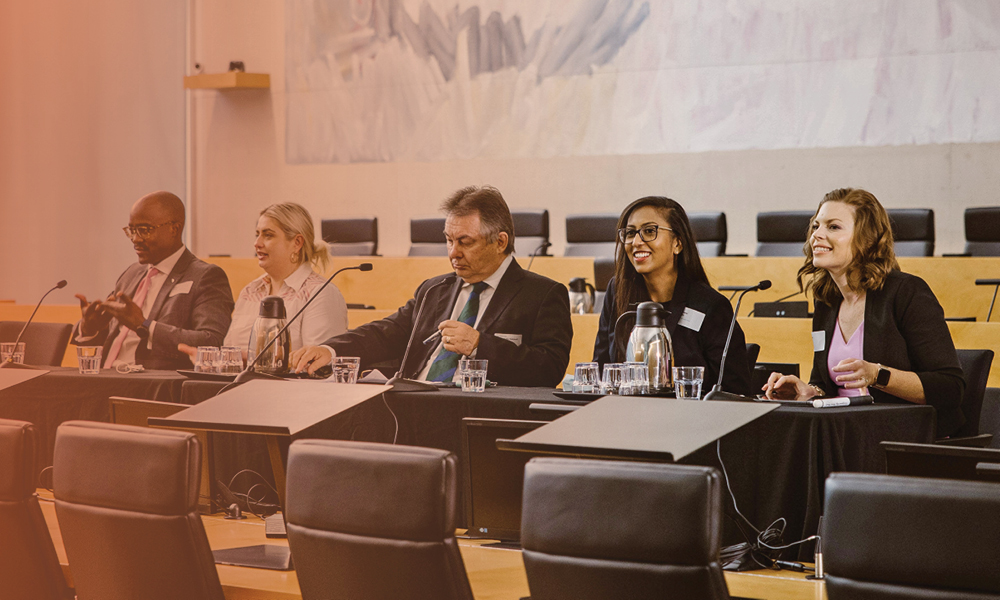Remember the very first time you attended court? The anticipation, the excitement, the adrenalin, the nerves! The fear of not wanting to make a fool of yourself.
On top of all that, imagine attending court with a disability. It amplifies those emotions. Where will I park, how will I access the building, will there be stairs or uneven paths, will I be able to hear properly or pick up on visual cues, how do I alert the judge to my impairment (if it is invisible) etcetera?
These are problems faced by people with disability – lawyers, parties to proceedings, witnesses, jurors, all court users.
I am a legally blind lawyer and have the privilege of being one of the founding members of the QLS Disability and Accessibility Network.
It is through my practice, and this network, that I have been notified of accessibility issues and barriers to participation and inclusion of people with disability.
People with disability are entitled to equal access to justice, with laws promoting the rights of people with a disability, prohibiting discrimination, and requiring reasonable adjustments to ensure access to public services, including the courts. Legislative frameworks1 lay the foundation for accessible courts, but their effective implementation often requires practical adjustments and a cultural shift to accommodate and encourage inclusion.
Despite legal protections, people with disabilities still encounter significant barriers when engaging with the judicial system, be it state or federal courts and tribunals, or regulator buildings in Queensland. Some of these barriers include:
- Physical accessibility: Heavy doors so that people in wheelchairs cannot easily operate them; lack of signage indicating wheelchair accessible toilets or entrances; lack of accessible parking within the building or nearby, requiring a support person to assist with transport; lift causing extreme vertigo requiring access to stairs; wheelchair lifts with a gate opening outwards onto a sloped path, forcing the person in a wheelchair to roll backwards into foot traffic.
- Sensory or communication accessibility: Inability to understand visual cues or body language requiring verbal direction; room acoustics interfering with sensory or neurodivergent impairments, delays or a lack of availability of qualified interpreters; reported attitudes of judicial officers (that I suspect, derives from miscommunication and misunderstanding).
- Digital Accessibility: Inability to file documents online, requiring significant effort on the part of a person with disability to file an original at the registry; access to alternative formats of court documents (not just hard copies) and the use of technological aids to assist vision impairments; conducting online appearances.
- Cognitive and mental health accessibility: People with cognitive impairments, including intellectual disabilities or mental health conditions, may find it difficult to navigate the court process, or struggle to understand legal jargon, participate in proceedings, or communicate effectively with their legal representatives. The absence of appropriate support services in court settings can exacerbate these difficulties.
Addressing these challenges requires both legal and practical solutions, such as:
- Reasonable adjustments;
- Design and infrastructure improvements;
- Training and awareness for personnel;
- Leveraging technology.
Some issues are complex with no blanket or easy fixes, but many can be solved with reasonable adjustments. Other issues may simply require notification to relevant parties so that a level of patience and understanding can be accommodated.
I distinctly remember one particular story recounted during my studies, where a judge refused to hear a lawyer because they did not respectfully stand to deliver their submissions. Unbeknown to the judge, the lawyer was in a wheelchair concealed by the bar table. Whether this story is true, is not resolutely known, but the key takeaway is the inevitable embarrassment and mortification on behalf of both parties upon realisation and how communication or prior notification could avoid such a scenario.
Interestingly, a study by the Lawyers with Disability Division of the UK Law Society found 90 per cent of legal professionals with disabilities have invisible impairments, but disclosure rates are low.2 Likely due to stigma and a history of denunciation.
Slowly however, society is becoming more accepting and inclusive of people from diverse backgrounds. Our participation matters!
Lawyers with disability are valuable contributors to the legal profession, as lived experiences of adversity and exclusion can provide added skills and benefits such as a person with disability naturally developing greater assertiveness, determination, resilience, and problem-solving skills than those without disability.3 In my experience, clients with disability or impairments often seek out advocates that have a lived experience, better understanding, and empathy of their situation.
While the courts have significantly improved accessibility, the accommodations actioned concentrate on removing physical barriers for wheelchair users. However, it is estimated only 4.4 per cent of people with disability in Australia, use a wheelchair.4 Not all disabilities are physical – some are sensory, some are invisible.5
Understandably, many barriers are not easily identifiable or readily known unless you are a person with disability and even then, sometimes not until you have lived experience accommodating that disability in certain situations.
Several years ago, I met with the Attorney-General as well as Court Services Queensland about accessibility in the courts and how to encourage people with disability to fully participate in the legal profession and court system.
We had originally pitched the idea of an ‘accessibility liaison’ and dedicated Queensland Courts webpage notifying details of whom people with disability could contact to raise accessibility queries.
Our experiences were validated, met with support and acceptance, and internal policies changed. Among our QLS Disability and Accessibility Network, we knew that we could contact the registrar of the relevant courthouse to direct our accessibility queries and request reasonable adjustments to facilitate our inclusion. Understandably, the preference was for registrars to address accessibility concerns locally as each courthouse is set up differently.
The problem is this accommodation is not common knowledge. There is no awareness or easily identifiable information on the website about court accessibility and how people with disability can be included.
Over time it has become evident that more awareness is needed. Our network has been notified of poor experiences of people with disability accessing the court system or facing mixed attitudes to their impairment and needs – not just limited to legal practitioners but experiences of all types of court users.
In some instances, it is unclear whether needs were appropriately communicated and understood.
Disability incorporates many impairments and even though I have a disability, I do not have all the answers. What I do know is that communication is key.
I suspect these poor experiences may stem from others not knowing a person has a disability (in circumstances where most are invisible and not disclosed) or not knowing how to best accommodate the disability. Likewise, a safe environment must be fostered in order to encourage disability disclosure or requests for assistance.
It is wonderful to see other jurisdictions such as New South Wales, Victoria and the Federal Court publishing access information for people with disability, inviting court users to submit a form for court assistance and reasonable adjustments if they can be accommodated.6
It is hoped Queensland will follow suit. If you have any court accessibility concerns or suggestions, the QLS Disability and Accessibility Network would love to hear from you. Our aim is to collate these experiences so that the network may approach the courts and offer our assistance identifying accessibility issues and potential improvements.
The ultimate goal is for a legal system where no one is left behind, regardless of their disability.
On International Day of People with Disability, let us turn our mind to how we may eliminate barriers to participation and inclusion, and put those accessibility ideas into action. Thank you for your support.
Do you have a story about court accessibility? The QLS Disability and Accessibility Network is calling for examples of lived experience to contribute to a future submission. You can share your story here anonymously.
Footnotes
1 Disability Services Act 2006 (Qld); Anti-Discrimination Act 1991 (Qld); Disability Discrimination Act 1992 (Cth).
2 Dr Natasha Hirst, ‘Significant barriers for disabled legal professionals’ (11 June 2018) Legally Disabled? <http://legallydisabled.com/2018/06/11/significant-barriers-for-disabled-legal-professionals/>.
3 Daniel Holt, Being a (Physically) Disabled Lawyer: the Lessons Learned (5 March 2018) Human Rights Lawyers Association <Being a (Physically) Disabled Lawyer: the Lessons Learned | Publications>.
4 Disability, Ageing and Carers, Summary of Findings 2015 (4430.0, 2016), Australian Bureau of Statistics; <4430.0 – Disability, Ageing and Carers, Australia: Summary of Findings, 2015 >.
5 There are no statistics regarding the prevalence of other types of disabilities in Queensland or Australia, however it is estimated 90% of legal professionals with disability in England and Wales have an invisible impairment.
6 See Services for people with disability; Access for people with disability; Accessibility – County Court of Victoria; Help for people with disabilities.












Share this article